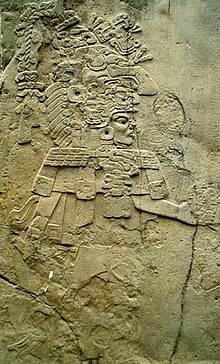
Back Estela 1 de La Mojarra Catalan Estela 1 de La Mojarra Spanish Stèle no 1 de La Mojarra French Stele nº 1 di La Mojarra Italian Estela 1 de La Mojarra NN Estela 1 de La Mojarra NB Stela 1 z La Mojarra Polish Estela 1 de La Mojarra Portuguese Stela 1 iz La Mojarre Serbo-Croatian
| La Mojarra Stela 1 | |
|---|---|
 Left side image of La Mojarra Stela 1, showing a person identified as "Harvester Mountain Lord". | |
| Material | Limestone |
| Created | 2nd century |
| Discovered | 1986 in the Acula River near La Mojarra, Veracruz, Mexico |
| Present location | Museo de Antropología, Xalapa, Veracruz |
La Mojarra Stela 1 is a Mesoamerican carved monument (stela) dating from 156 CE[1] (2nd century CE). It was discovered in 1986, pulled from the Acula River near La Mojarra, Veracruz, Mexico, not far from the Tres Zapotes archaeological site. The 4+1⁄2-foot-wide (1.4 m) by 6+1⁄2-foot-high (2.0 m), four-ton limestone slab contains about 535 glyphs of the Isthmian script. One of Mesoamerica's earliest known written records, this Epi-Olmec culture monument not only recorded this ruler's achievements, but placed them within a cosmological framework of calendars and astronomical events.[2]
The right side of the stone features a full-length portrait of a man in an elaborate headdress and costume, although the bottom half of the carving is very badly weathered. Above the figure, 12 short columns of glyphs have been etched into the stone, matched by eight longer columns to the figure's right. Among these glyphs are two Mesoamerican Long Count calendar dates which correspond to May 143 CE and July 156 CE. The monument is an early example of the type of stela which later became common commemorating rulers of Maya sites in the Classic era.
© MMXXIII Rich X Search. We shall prevail. All rights reserved. Rich X Search